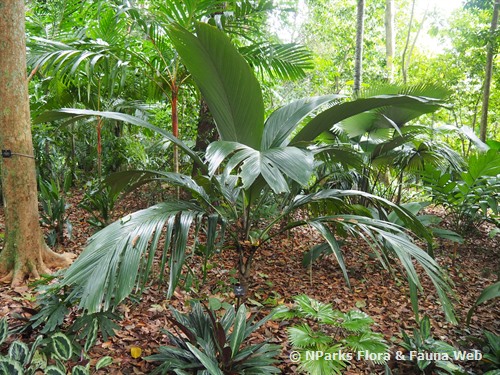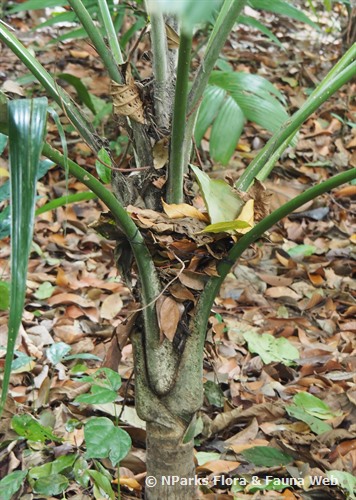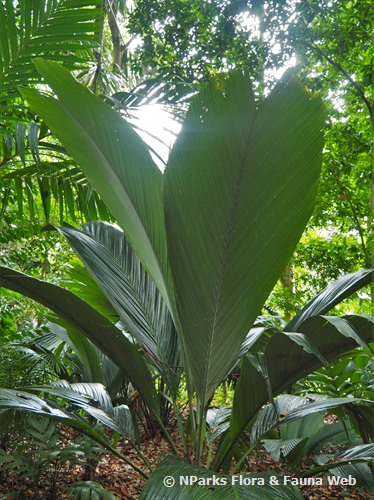
Name
Classifications and Characteristics
| Plant Division | Angiosperms (Flowering Seed Plants) |
|---|---|
| Plant Growth Form | Palm (Solitary Habit) |
Biogeography
| Native Distribution | Marquesas Islands |
|---|---|
| Native Habitat | Terrestrial |
| Preferred Climate Zone | Tropical |
Description and Ethnobotany
| Growth Form | It is a solitary palm with no spines, and trunk marked with compressed leaf scars. |
|---|---|
| Foliage | Leaves are large and arching, though undivided except for the bifid leaf tips, they are often split pinnately by wind. Fibrous leaf sheaths do not form a crown shaft. Leaves are shiny green above and thinly covered in grey hairs on the underside. |
| Flowers | Inflorescence is solitary and occurs between the leaves. Prophyll is densely hairy, only partially enclosing the inflorescence and splits at the tip when mature. Inflorescence comprises of both male and female flowers (monoecious), where female flowers are larger than male flowers at anthesis. |
| Fruit | Fruit are large (10 – 15 cm diameter), round with corky protrusion, and ripen light brown. During development, fruit are hollow and filled with liquid inside, which only solidify a few weeks before maturity. |
| Habitat | It is found in the undergrowth of rainforest. |
| Etymology | Pelagos, is greek for sea; doxa is greek for glory, possibly referring to the oceanic island where the genus was described. Specific epithet henryana commemorates Charles Henry, a plant collector in the Marquesas who collected the type specimen for this species in 1916. |
| Ethnobotanical Uses | Edible Plant Parts : Edible Seeds Food (Fruit or Vegetable) Others: Young seeds are said to be edible and sweetly aromatic. |
Landscaping Features
| Desirable Plant Features | Ornamental Form |
|---|
Plant Care and Propagation
| Light Preference | Semi-Shade |
|---|---|
| Water Preference | Moderate Water |
| Plant Growth Rate | Moderate |
| Rootzone Tolerance | Well-Drained Soils |
Foliar
| Foliage Retention | Evergreen |
|---|---|
| Mature Foliage Colour(s) | Green |
Non - Foliar and Storage
| Trunk Type (Palm) | Solitary Habit, Aboveground |
|---|
Fruit, Seed and Spore
| Mature Fruit Colour(s) | Brown |
|---|---|
| Mature Fruit Texture(s) | Bumpy / Tuberculate |
References
| References | Chapin, M.H., Essig, F.B. and Pintaud, J.C.. 2001. The Morphology and Histology of the Fruits of Pelagodoxa (Arecaceae): Taxonomic and Biogeographical Implications. Systematic Botany . 26 (4). 779 - 785 Dowe, J.L. & Chapin, M.H.. 2006. Beccari’s “Grande Nouveaute”: the Discovery, Taxonomic History and Typification of Pelagodoxa henryana. PALMS. 50 (4). 185 - 192 Dransfield, J., Uhi, N.W., Asmussen, C.B., Baker, W.J., Harley, M.M. & Lewis, C.E. . 2008. Genera Palmarum. The Evolution and Classification of Palms. . United Kingdom: Kew Publishing. 732 |
|---|
Image Repository
Others
| Master ID | 30214 |
|---|---|
| Species ID | 4523 |
| Flora Disclaimer | The information in this website has been compiled from reliable sources, such as reference works on medicinal plants. It is not a substitute for medical advice or treatment and NParks does not purport to provide any medical advice. Readers should always consult his/her physician before using or consuming a plant for medicinal purposes. |


